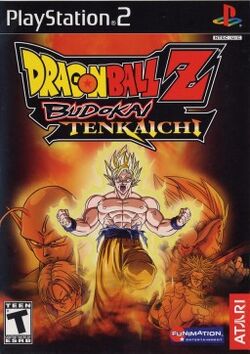| Dragon Ball Z: Budokai Tenkaichi | |
|---|---|

| |
| Developer(s) | Spike |
| Publisher(s) | Bandai (JP) Atari (US) |
| Series | Budokai Tenkaichi series |
| Picture format | 480i (SDTV) |
| Release date(s) | JPN October 6, 2005 US October 18, 2005 EU October 21 2005 |
| Genre(s) | Fighting |
| Mode(s) | Singleplayer, Multiplayer |
| Rating(s) | ESRB: T PEGI: 12 |
| Platform(s) | PlayStation 2 |
| Media | DVD-ROM |
| Input | DualShock 2 |
| Video games Listing - Category | |
Dragon Ball Z: Budokai Tenkaichi, originally published in Japan as Dragon Ball Z: Sparking! (ドラゴンボールZ Sparking!, Doragon Bōru Zetto Supākingu!), is a fighting video game released for the PlayStation 2 in Japan on October 6, 2005, and in North America on October 18, 2005. The game was developed by Spike and published by Atari and Bandai in the US and Japan respectively. The game features 58 playable characters with a total of 90 playable forms from the various TV series and movies. In addition, this game has fully destructible environments. In October/November of 2006, Dragon Ball Z: Budokai Tenkaichi 2 was released as the game's first sequel.
Name[]
The "Sparking!" in the Japanese title references both the first and last word in the first opening theme to the Dragon Ball Z TV series, "Cha-La Head-Cha-La" (performed by Hironobu Kageyama). However, the opening theme to the game is the TV series' second opening theme, "WE GOTTA POWER!" (featured in the Japanese version; the American and European versions includes a different, non-vocal song), which is also sung by Hironobu Kageyama.
The "Budokai Tenkaichi" title of the North American version is a rearranged version of Tenkaichi Budōkai (天下一武道会, roughly "Strongest Under the Heavens Martial Arts Tournament"). In the series, the Tenka-ichi Budôkai is a gathering of fighters in a competition for glory, fame, and prize money.
The game is not considered a part of the Budokai series of games, despite its misleading title. In addition to a completely different game engine, the game was developed by an entirely different company (Spike as opposed to Dimps). The game is also titled differently from the rest of the Budokai series in Japan. Were it a true Budokai game, it would have been named Dragon Ball Z 4 in Japan. Speculation on the English re-title is that Atari chose to market the game as part of the Budokai series in order to capitalize on a pre-existing market of fans already familiar with said game series. The English version also uses a great deal of sound effects and background music made for the Budokai series.
Gameplay[]
The game is quite different from the often-compared Budokai series; it uses a "behind-the-back" camera perspective. Many fans say that the game feels like a combination of the Budokai series and the game engine from Idainaru Doragonbôru Densetsu for Sega Saturn and PlayStation. Although the engine is more like a typical third-person shooter, it is difficult to master.
Unlike the Budokai series, there are no in-game transformations, but characters can also be selected from the get go in there intial transformation (for example, starting a battle in SSj, instead of your base form.).
Playable characters[]
Despite not being a part of the series, the vast majority of characters from the Budokai series once again make an appearance. Additional villains such as Zarbon and Dodoria from the first Budokai game (but not present in the two sequels) appear in the game's roster (though not present from the Budokai series are Kaiôshin, Uub, and Yi Xing Long). Some of the characters making their first-ever playable appearances are Janemba, the Great Ape, Baby Vegeta, and Super #17.
There are various classes of characters with special abilities that alter the battle:
- Jinzôningen (Artificial Humans) - Will not show on radar unless locked on to. Cannot charge ki (unless ki gauge is full, then may charge as normal to enter Max Power mode). Energy absorption models gain ki by absorbing incoming energy dan attacks. Unlimited energy models constantly replenish ki at a consistent rate. The gauge can also be filled as normal by landing successful melee attacks, just like any other character.
- Large Characters (ex: Broly) - Do not flinch from smaller characters' melee attacks. The characters that have this "Brick wall" effect are Broly, Bojack, Super Saiyan 3rd Grade Trunks, Great Ape, Great Ape Vegeta and Android 16.
- Great Ape - Do not flinch from smaller characters' melee attacks, and cannot be thrown or hit with a Dragon Dash-type finishing move.
- Scouter (ex: Bardock) - Can lock onto an opponent from anywhere using the scouter, however it takes a few moments for them to turn the scouter on and then begin looking around, but the scouter is broken when the character takes a certain amount of damage. The characters that have scouters include: Raditz, Nappa, Scouter Vegeta, Dodoria, Zarbon, Recoome, Burter, Jeice, Captain Ginyu and Bardock.
- Mr. Satan (Hercule in the edited FUNimation dub, and in the games) - None of the other characters "flinch" when hit by his melee attacks. (not even another Mr. Satan)
- Majin Buu - All of Buu's forms recover health slowly over time.